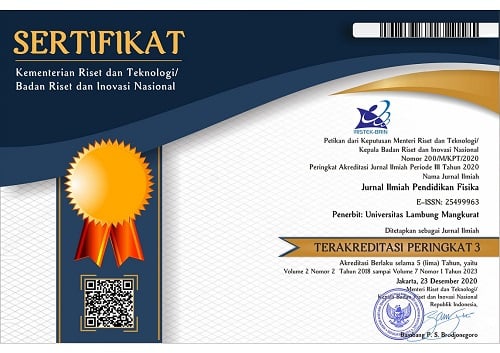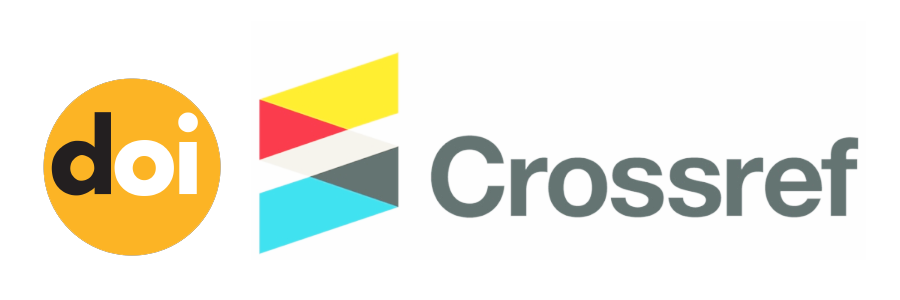STEM Quartet to Improve Creative Thinking Skills (CreaTS) for High School Students in Physics Learning
Abstract
This study aims to improve high school students' creative thinking skills (CreaTS) in physics learning by applying the STEM Quartet. This study used an experimental design with the pre-experimental method, and the design used was a one-group pretest-posttest design. The population in this study were all students of class X at a high school in Bandung. The sampling technique in this study was purposive. The sample for this research is 16 students aged 15 to 16 years. The instrument in this study was the CreaTSIT (Creative Thinking Skill Instrument Test) in the form of an essay consisting of 20 items. Data were analyzed using the gain score, Wilcoxon signed rank test, stacking, and racking. The results showed a significant difference between the pretest and posttest scores with a p-value of 0.00 and an increase in creative thinking skills (CreaTS) in each indicator with an N-Gain value of 0.67 in the medium category. The four aspects of creation experienced increases, changes in the difficulty level of items, and changes in students' creative thinking skills, as shown through stacking and racking analysis. This study suggests that applying the STEM Quartet can be used as an alternative to improve students' creative thinking skills (creaTS) and can contribute to the world of Indonesian education, especially for physics teachers and physics education researchers.
Keywords
Full Text:
PDFReferences
Amelia, T., Jumini, S., & Khoiri, A. (2021). Analysis of creativity and attitudes caring the environment of junior high school students: study of environmental physics learning using learning modules. Jurnal Pendidikan Fisika Indonesia, 17(1), 40–48. https://doi.org/10.15294/jpfi.v17i1.26301
Batlolona, J.R., Markus, D., & Eny, L. (2019). Creative thinking skills students in physics on solid material elasticity: Turkish Science Education, 16(1). https://www.tused.org/index.php/tused/article/view/209
Creswell, J. W., & Clark, V. L. P. (2018). Praise for the Third Edition. 849.
Darman, D. R. (2021). Online problem based learning (OPBL) assisted by simulation media in basic physics learning to improve creative thinking skills. Gravity : Jurnal Ilmiah Penelitian Dan Pembelajaran Fisika, 7(1). https://doi.org/10.30870/gravity.v7i1.10008
D.J. Treffinger, G.C. Young, E.C. Selby, & C. Shepardson. (2002). Assessing creativity: A guide for educator. The National Research Center .
Habibi, Mundilarto, Jumadi, J., Gummah, S., Ahzan, S., & Prasetya, D. S. B. (2020). Project brief effects on creative thinking skills among low-ability pre-service physics teachers. International Journal of Evaluation and Research in Education, 9(2), 415–420.
https://doi.org/10.11591/ijere.v9i2.20531
Istiyono, E., Widihastuti, W., Supahar, S., & Hamdi, S. (2020). Measuring creative thinking skills of senior high school male and female students in physics (ctsp) using the irt-based phystcrets. Journal of Turkish Science Education, 17(4), 578–590. https://doi.org/10.36681/tused.2020.46
Julfitri, E., Efwinda, S., & Zulkarnaen, Z. (2020). The C3PDR learning model to increase conceptual understanding and creative thinking skills of senior high school students. Berkala Ilmiah Pendidikan Fisika, 8(3), 170. https://doi.org/10.20527/bipf.v8i3.9113
Kelley, T. (2016). A Conceptual framework for integrated STEM education. International Journal of STEM Education, 3(1).
Khoiri, A., Nulngafan, N., Sunarno, W., & Sajidan, S. (2019). How is students’ creative thinking skills? an ethnoscience learning implementation. Jurnal Ilmiah Pendidikan Fisika Al-Biruni, 8(2), 153–163. https://doi.org/10.24042/jipfalbiruni.v0i0.4559
Laliyo, L. A. R., Sumintono, B., & Panigoro, C. (2022). Measuring changes in hydrolysis concept of students taught by inquiry model: stacking and racking analysis techniques in Rasch model. Heliyon, 8(3), e09126. https://doi.org/10.1016/j.heliyon.2022.e09126
Malik, A., Denya Agustina, R., & Alisia Wardhany, W. (2019). Improving creative thinking skills of student related to the concept work and energy. Journal of Physics: Conference Series, 1175(1). https://doi.org/10.1088/1742-6596/1175/1/012180
Malik, A., Nuraeni, Y., Samsudin, A., & Sutarno, S. (2019). Creative thinking skills of students on harmonic vibration using model student facilitator and explaining (SFAE). Jurnal Ilmiah Pendidikan Fisika Al-Biruni, 8(1), 77–88. https://doi.org/10.24042/jipfalbiruni.v8i1.3056
Meiarti, D. (2019). Mind mapping based creative problem solving: Train the creative thinking skills of vocational school students in physics learning. https://doi.org/10.21009/1
Muchsin, M., & Mariati, M. (2020). Application of project based learning models in improving creative thinking of students at physics lessons in sma bandar baru. Budapest International Research and Critics Institute (BIRCI-Journal): Humanities and Social Sciences, 3(2), 1453–1458. https://doi.org/10.33258/birci.v3i2.1008
Neolaka, F., & Corebima, A. D. (2018). Comparison between correlation of creative thinking skills and learning results, and correlation of creative thinking skills and retention in the implementation of predict observe explain (POE) learning model in senior high schools in malang, indonesia. Educational Process: International Journal, 7(4), 237–245.
https://doi.org/10.22521/edupij.2018.74.2
Pratiwi, R. D., Ashadi, A., Sukarmin, S., & Harjunowibowo, D. (2019). Students’ creative thinking skills on heat phenomena using POGIL learning model. Jurnal Ilmiah Pendidikan Fisika Al-Biruni, 8(2), 221–231. https://doi.org/10.24042/jipfalbiruni.v0i0.4629
Prima, N. (2021). Validity of students worksheet using creative problem based learning model in physics learning on senior high school. International Journal of Progressive Sciences and Technologies (IJPSAT, 28(1), 145–150. http://ijpsat.ijsht-journals.org
Puspitasari, A. D., Sukarelawan, M. I., Damayanti, E. N., Syifa, A., & Fitri, F. (2022). Model pembelajaran predict observe explain dalam edmodo untuk meningkatkan pemahaman konsep fisika di SMP: Analisis stacking. Berkala Fisika Indonesia : Jurnal Ilmiah Fisika, Pembelajaran Dan Aplikasinya, 13(1), 32.
https://doi.org/10.12928/bfi-jifpa.v13i1.23204
Putranta, H., & Supahar. (2019). Development of physics-tier tests (PysTT) to measure students’ conceptual understanding and creative thinking skills: A qualitative synthesis. Journal for the Education of Gifted Young Scientists, 7(3), 747–775. https://doi.org/10.17478/jegys.587203
Putri, N., Rusdiana, D., & Suwarma, I. R. (2019). The comparison of student creative thinking skill using cbl implemented in stem education and combined with psl worksheet in indonesian school. Journal of Science Learning, 3(1), 7–11. https://doi.org/10.17509/jsl.v3i1.17557
Ramdani, A., Artayasa, I. P., Yustiqvar, M., & Nisrina, N. (2021). Enhancing prospective teachers’ creative thinking skills: a study of the transition from structured to open inquiry classes. Cakrawala Pendidikan, 40(3), 637–649. https://doi.org/10.21831/cp.v40i3.41758
Sagala, R., Umam, R., Thahir, A., Saregar, A., & Wardani, I. (2019). The effectiveness of stem-based on gender differences: The impact of physics concept understanding. European Journal of Educational Research, 8(3), 753–761. https://doi.org/10.12973/eu-jer.8.3.753
Sahida, D., & Zarvianti, E. (2019). Development of Problem Based Learning (PBL) practicum guide to improve student Creative Thinking Skills (CTS) in basic physics subject. Journal of Educational and Learning Studies, 2(1), 39. https://doi.org/10.32698/0492
Saprudin, ., Liliasari, ., Prihatmanto, A. S., & Setiawan, A. (2019). The potential of gamification in developing pre-service physics teachers’ critical and creative thinking skills. Omega: Jurnal Fisika Dan Pendidikan Fisika, 5(1), 7. https://doi.org/10.31758/omegajphysphyseduc.v5i1.7
Saregar, A., Cahyanti, U. N., Misbah, Susilowati, N. E., Anugrah, A., & Muhammad, N. (2021). Core learning model: Its effectiveness towards students’ creative thinking. International Journal of Evaluation and Research in Education, 10(1), 35–41. https://doi.org/10.11591/ijere.v10i1.20813
Satriawan, M., Liliasari, S., & Setiawan, W. (2019). Wave energy concept mastery relate on creative thinking skills of the pre-service physics teachers in environmental physics lectures. Journal of Physics: Conference Series, 1157(3). https://doi.org/10.1088/1742-6596/1157/3/032044
Sokolowski, A. (2018). Scientific inquiry in mathematics-theory and practice: a stem perspective. Springer International Publishing AG. https://doi.org/10.1007/978-3-319-89524-6
Sugiyono. (2018). Metode penelitian kuantitatif, kualitatif, dan R&D (27th ed.). Alfabeta.
Sunjaya, D. K., Herawati, D. M. D., Indraswari, N., Megawati, G., & Sumintono, B. (2021). Training and assessing model for the ability of community health volunteers in anthropometric measurement using the rasch stacking and racking analyses. Journal of Environmental and Public Health, 2021. https://doi.org/10.1155/2021/5515712
Tan, A.-L., Teo, T. W., Choy, B. H., & Ong, Y. S. (2019). The S-T-E-M Quartet. Innovation and Education, 1(1), 1–14. https://doi.org/10.1186/s42862-019-0005-x
Teo, T. W., Tan, A. L., Ong, Y. S., & Choy, B. H. (2021). Centricities of STEM curriculum frameworks: Variations of the S-T-E-M Quartet. STEM Education, 1(3), 141–156. https://doi.org/10.3934/steme.2021011
Wartono, W., Diantoro, M., & Bartlolona, J. R. (2018). Influence of problem based learning learning model on student creative thinking on elasticity topics a material. Jurnal Pendidikan Fisika Indonesia, 14(1), 32–39. https://doi.org/10.15294/jpfi.v14i1.10654
Widyasari, F., Masykuri, M., Mahardiani, L., Saputro, S., & Yamtinah, S. (2022). Measuring the effect of subject-specific pedagogy on TPACK through flipped learning in e-learning classroom. International Journal of Instruction, 15(3), 1007–1030. https://doi.org/10.29333/iji.2022.15354a
Witdiya, T., Supriadi, G., Supriatin, A., & Annovasho, J. (2023). The effect of STEAM learning on improving each indicator of students’ creative thinking in physics learning. Jurnal Ilmiah Pendidikan Fisika, 7(1), 42. https://doi.org/10.20527/jipf.v7i1.7158
Zarvianti, E., & Sahida, D. (2020). Designing comics by using problem based learning (PBL) to improve student’s creative thinking skills. International Journal of Social Learning (IJSL), 1(1), 75–88. https://doi.org/10.47134/ijsl.v1i1.8
DOI: https://doi.org/10.20527/jipf.v7i3.9696
Refbacks
- There are currently no refbacks.
Indexed by: Jurnal Ilmiah Pendidikan Fisika is licensed under a creative commons attribution-share alike 4.0 international license
Statistics Counter |
















